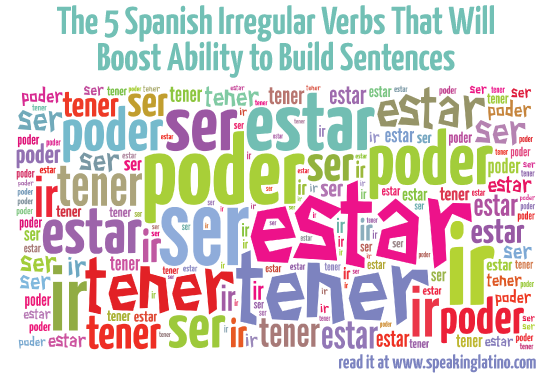
Sponsored Post: This is a guest post written by Angela Cardenas, one of the creators of the series of Spanish learning books Spanish at Home and Bright Spanish live video courses. She has years of experience teaching Spanish to students in Los Angeles and this is her first contribution to Speaking Latino.
The 5 Spanish Irregular Verbs That Will Boost Ability to Build Sentences
by Angela Cardenas
If your main goal is conversation, traditional rules put heavy emphasis on things you may never use or need. Learning languages can be challenging enough without having a few good tips and tricks in your pocket.
It’s true that learning the basics of the Spanish language will give you the freedom to form sentences and get around quite easily in any Spanish-speaking country. But it’s not always possible to learn fluency before one might need to speak the language. That’s where a few tips and tricks come in, plus a bit of memorization.
It all starts with verbs, right?
Verbs are a particularly important part of speech, and they are the staple of every language. Think about it. Even cave-people spoke in verbs. “Go.” “Eat.” “Hunt.” So, it goes without saying that learning five of the most used Spanish verbs will go a long way.
5 Spanish irregular verbs everyone should know
These verbs were selected because they will help boost your ability to create sentences in present and future tenses.
Irregular verbs get used regularly
The bad news is that each of these verbs is irregular – so they don’t follow the typical conjugation endings (-er, -ar, -ir). The good news is that these verbs are so valuable that once you memorize them, you will be able to construct sentences more easily.
1. To go (ir)
yo voy
tú vas
él va / ella va / usted va
nosotros vamos
vosotros vais
ellos van / ellas van / ustedes van
2. To be (estar)
yo estoy
tú estás
él está /ella está /usted está
nosotros estamos
vosotros estáis
ellos están / ellas están / ustedes están
3. To be (ser)
yo soy
tú eres
él es /ella es / usted es
nosotros somos
vosotros sois
ellos son / ellas son / ustedes son
4. To be able to, can (poder)
yo puedo
tú puedes
él puede /ella puede /usted puede
nosotros podemos
vosotros podéis
ellos pueden / ellas pueden / ustedes pueden
5. To have (tener)
yo tengo
tú tienes
él tiene/ella tiene/usted tiene
nosotros tenemos
vosotros tenéis
ellos/ellas/ustedes tienen
Tip: Make flash cards on your tablet or on index cards to practice until the conjugations are rote. Here are 5″ x 3″ printable flashcards that you can download and print.
The obvious choices of: To be (ser), To be (estar) and To have (tener) are included as they are used more frequently than any of the other verbs on the roster. We’ve added the additional two for their popularity, and also for their ability to perform double duty services.
Poder (to be able to, can) and Ir (to go) are extremely useful when creating sentences without knowing the conjugation of many verbs. The examples will demonstrate what we mean.
Example #1: If you don’t know how to conjugate “to eat” (comer), and you want to say, “I can eat now.” You can simply use “yo puedo comer ahora.” See, how simple? We’ve used the conjugated form of “I can” and added the infinitive of to eat, “comer” and formed the sentence so it is completely understandable.
We’ve used a similar trick in the next example:
Example #2: Let’s say you want to talk about doing something in the future. All you have to do is conjugate the “to go” verb (ir) and add it to the infinitive of the verb of whatever it is you want to do. So, if you want to say, “I am going to see the movie tomorrow,” you can construct the sentence like this: “Yo voy a ver la película mañana.”
Once again, you are using the infinitive of the active verb without having to know its conjugation. See? Now you try it.
It is easy, once you learn how to conjugate the five verbs above. Go on and memorize them soon!
We’ll be back with more tips and tricks on how to come up with quick ways to communicate while in Spanish-speaking countries. Our techniques have been designed to bring out skills you didn’t know you had. Our goal is for you to learn Spanish the way that suits you the best!
Check out these other articles about How to Speak Spanish.